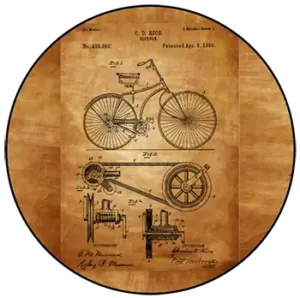What is a provisional patent application for a patent?
A provisional patent application is a type of application that can be filed with a patent office, such as the United States Patent and Trademark Office (USPTO), to establish a filing date for an invention. It is a simplified and less formal alternative to a regular (non-provisional) patent application. The primary purpose of a provisional patent application is to secure an early filing date for your invention without the need to provide a full and formal patent application
Here are some key points about provisional patent applications:
- Filing Date Protection: By filing a provisional application, you establish a priority date for your invention. This is important because patents are typically granted to the first person who invents a particular technology or product. If someone else later invents the same thing and applies for a patent, your provisional application’s filing date can be used to establish that you had the idea first.
- Informal and Less Expensive: Provisional applications are less formal and generally less expensive to file than non-provisional patent applications. They do not require formal patent claims or detailed patent drawings. This makes them a more accessible option for inventors and startups with limited resources.
- Temporary Protection: A provisional patent application does not, by itself, result in the grant of a patent. It provides temporary protection for one year. During this time, you can file a non-provisional patent application (regular patent application) that claims the benefit of the earlier-filed provisional application’s filing date. This allows you to work on your invention, seek funding, or further develop your ideas before committing to the expense of a full patent application.
- No Examination: Provisional applications are not examined by the patent office. To obtain a granted patent, you must follow up with a non-provisional application, which undergoes a thorough examination process.
- Detailed Disclosure: While provisional applications are less formal, it’s still important to provide a clear and complete description of your invention. This is because the later non-provisional application must be supported by the disclosure in the provisional application to claim the benefit of the earlier filing date.
- Conversion: If you choose not to file a non-provisional application within the one-year period, your provisional application will be abandoned, and you will lose the priority date it established.
Can I file a provisional patent myself?
Yes, you can file a provisional patent application yourself without the assistance of a patent attorney or agent. Many inventors, especially those with limited resources, choose to prepare and file their provisional patent applications. However, there are some important things to keep in mind if you decide to go this route:
- Thorough Description: You must provide a clear and complete description of your invention in the provisional application. This includes detailed written descriptions and any necessary drawings or diagrams. The level of detail should be sufficient for someone skilled in the field to understand how to make and use the invention.
- Follow the Requirements: Ensure that your provisional application complies with the formal requirements of the patent office where you plan to file it, such as the United States Patent and Trademark Office (USPTO). These requirements can vary by jurisdiction, so it’s important to understand and follow their specific guidelines.
- Limited Legal Guidance: When filing a provisional application on your own, you won’t have the benefit of legal advice or guidance on patent strategy. Patent professionals can provide valuable insights into the broader patent landscape, potential prior art, and the best approach to protect your invention.
- No Examination: Keep in mind that a provisional application does not undergo examination by the patent office. It is not evaluated for patentability. To obtain a granted patent, you’ll need to follow up with a non-provisional application, and that is where a patent examiner reviews the application and assesses its patentability.
- Deadlines: Be aware of the one-year deadline for converting your provisional application into a non-provisional application. Failure to meet this deadline can result in the loss of your priority date.
If you choose to file a provisional patent application on your own, it’s a good idea to familiarize yourself with the patent application process and requirements, and consider using the resources and guidelines provided by the relevant patent office (e.g., the USPTO’s website for U.S. inventors). Additionally, while you can file a provisional application on your own, many inventors still find value in consulting with a patent attorney or agent at some point during the process to ensure that their invention is adequately protected and to help navigate the transition to a non-provisional application if needed.
What is the benefit of a provisional patent? A provisional patent application offers several benefits:
- Priority Date: It establishes an early filing date for your invention. If someone else later files a patent for the same invention, your priority date can protect your rights.
- Temporary Protection: Provides one year of provisional patent protection. During this time, you can label your invention as “patent-pending,” which can deter competitors.
- Cost-Effective: Filing a provisional application is generally less expensive and less formal than a non-provisional application.
- Time to Develop: It allows you to continue developing your invention, secure funding, or gauge market interest before committing to the expense of a full patent application.
- No Examination: The provisional application itself is not examined, reducing the initial administrative burden.
- Flexibility: You can choose to convert it into a non-provisional application within a year to seek full patent protection.
Overall, a provisional patent application provides a valuable tool for inventors to protect their innovations without immediate high costs and while retaining flexibility.
Drawbacks of provisional patents
- Limited Protection: Provisional patents only offer one year of protection. If you don’t file a non-provisional application within this timeframe, you lose your priority date.
- No Examination: Provisional applications are not examined for patentability, so you have no assurance of whether your invention is truly patentable.
- Incomplete Protection: Incomplete or poorly drafted provisional applications may provide insufficient support for a non-provisional application, jeopardizing your patent rights.
- Legal Expertise: Without legal guidance, you may not fully understand how to strategically protect your invention and navigate the patent process.
- Costs Over Time: While initially cost-effective, the cumulative costs of both a provisional and non-provisional application can be higher than filing a non-provisional application from the start.
- No Rights Until Conversion: You have no enforceable patent rights until the provisional application is converted into a non-provisional one.
How difficult is it to file a provisional patent?
Filing a provisional patent application is relatively straightforward, as it doesn’t require formal patent claims or detailed drawings. However, it can be challenging to ensure your application provides a comprehensive and clear description of your invention. While legal expertise is not mandatory, many inventors find it beneficial to avoid potential pitfalls and maximize the application’s effectiveness.
Do provisional patents get rejected?
Provisional patent applications are not subject to examination by patent offices, so they are not rejected. Their purpose is to secure a filing date and provide temporary protection. However, if the subsequent non-provisional application that claims the benefit of the provisional is not accepted, your patent claims can be rejected during the examination of the non-provisional application. It’s important to ensure that the non-provisional application is well-prepared and meets patentability requirements to obtain a granted patent.
What happens after you file a provisional patent?
After filing a provisional patent application, you have one year to follow up with a non-provisional application. This step involves a comprehensive and formal submission with patent claims. The provisional application’s filing date is claimed in the non-provisional application. It then undergoes examination by the patent office. If approved, it may lead to the grant of a patent, providing full protection for your invention.
How long after a provisional patent expires?
A provisional patent application provides one year of temporary protection. After it expires, if you haven’t filed a corresponding non-provisional patent application, you lose the priority date established by the provisional application. To protect your invention further, you should file a non-provisional application within this one-year period.





